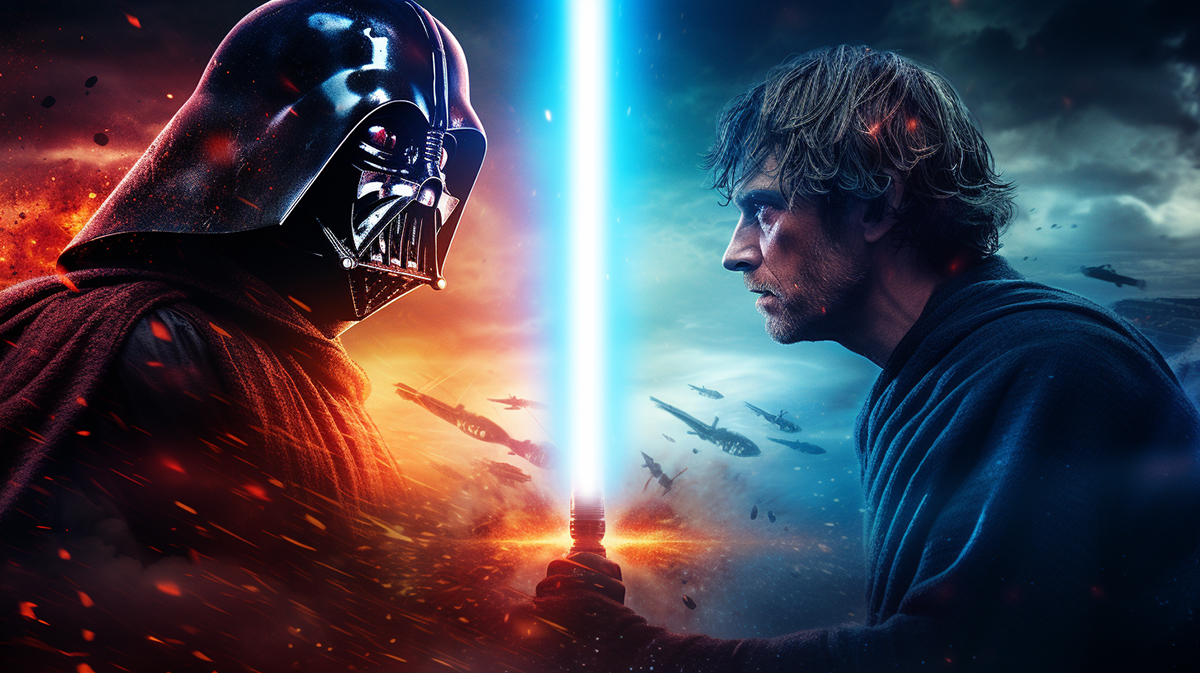The Epic Journey of the Star Wars Saga

The “Star Wars” series, an epic space opera, has been a cultural phenomenon since its inception in 1977. Created by the visionary George Lucas, the series has captivated audiences worldwide with its compelling storylines, iconic characters, and groundbreaking special effects. The series has not only revolutionized the film industry but also left an indelible mark on popular culture.
From the moment the first film, “Star Wars: A New Hope,” hit the screens, it was clear that the world was witnessing something extraordinary. The film introduced audiences to a galaxy far, far away, filled with diverse species, advanced technology, and mystical powers. The film’s success was unprecedented, grossing over $775 million worldwide and winning six Academy Awards. A New Hope won in the categories of Best Original Score, Best Visual Effects, Best Film Editing, Best Costume Design, Best Sound & Mixing, and Best Art Direction.
The series’ iconic characters, such as Luke Skywalker, Princess Leia, Han Solo, and Darth Vader, have become household names. These characters, with their distinct personalities and complex relationships, have resonated with audiences, making the series a timeless classic.
The groundbreaking special effects used in the “Star Wars” film series have set a new standard in the film industry. The series’ use of models, miniatures, computer-generated imagery (CGI), and practical effects has been instrumental in bringing the fantastical world of “Star Wars” to life. The series’ innovative use of technology has earned it numerous awards and accolades, including the Special Achievement Academy Award for Visual Effects.
The “Star Wars” film series has grossed over $10 billion worldwide, making it one of the highest-grossing film franchises of all time. The series’ cultural impact is immeasurable, influencing everything from fashion and music to literature and politics. The “Star Wars” film series is more than just a collection of films; it’s a cultural touchstone that continues to inspire and entertain generations of fans.
The Original Trilogy
The original “Star Wars” trilogy, consisting of “A New Hope,” “The Empire Strikes Back,” and “Return of the Jedi,” set the standard for science fiction films. Released between 1977 and 1983, these films introduced audiences to a galaxy far, far away and the timeless battle between good and evil.
“A New Hope,” released in 1977, was the first film in the series. It introduced audiences to the characters of Luke Skywalker, Princess Leia, and Han Solo, and the villainous Darth Vader. The film was a massive success, setting the stage for the epic saga that would follow.
“The Empire Strikes Back,” released in 1980, is often considered the best film in the series. It deepened the characters and the story, introducing the wise Yoda and revealing the shocking truth about Darth Vader’s identity. The film was both a critical and commercial success, grossing over $538 million worldwide.
“Return of the Jedi,” released in 1983, concluded the original trilogy. The film saw the redemption of Darth Vader and the ultimate victory of the Rebel Alliance over the Galactic Empire. Despite mixed reviews, the film was a commercial success, grossing over $475 million worldwide.
The original trilogy’s impact on popular culture cannot be overstated. It introduced the world to the “Star Wars” universe and set the standard for all science fiction films that followed. The trilogy’s innovative special effects, compelling story, and memorable characters have made it a timeless classic.
The Prequel Trilogy
The prequel trilogy, which includes “The Phantom Menace,” “Attack of the Clones,” and “Revenge of the Sith,” delves into the backstory of the original characters and the rise of the Galactic Empire. Released between 1999 and 2005, these films added depth to the “Star Wars” universe, despite receiving mixed reviews.
“The Phantom Menace,” released in 1999, introduced audiences to a young Anakin Skywalker, the future Darth Vader. The film also introduced the concept of the Force and the Jedi Order in more depth. Despite mixed reviews, the film was a commercial success, grossing over $1 billion worldwide.
“Attack of the Clones,” released in 2002, continued the story of Anakin Skywalker’s descent into darkness. The film also introduced the Clone Wars, a major conflict in the “Star Wars” universe. Despite mixed reviews, the film was a commercial success, grossing over $649 million worldwide.
“Revenge of the Sith,” released in 2005, concluded the prequel trilogy. The film depicted the fall of Anakin Skywalker and the rise of Darth Vader, as well as the transformation of the Republic into the Galactic Empire. Despite mixed reviews, the film was a commercial success, grossing over $849 million worldwide.
The prequel trilogy, despite its mixed reception, added depth and complexity to the “Star Wars” universe. It provided the backstory for the original characters and set the stage for the events of the original trilogy.
The Sequel Trilogy
The sequel trilogy, consisting of “The Force Awakens,” “The Last Jedi,” and “The Rise of Skywalker,” continues the saga with a new generation of characters. Released between 2015 and 2019, these films have been both commercially successful and critically acclaimed, proving the enduring appeal of the “Star Wars” series.
“The Force Awakens,” released in 2015, introduced audiences to new characters like Rey, Finn, and Poe Dameron, while also bringing back beloved characters from the original trilogy. The film was a massive success, grossing over $2 billion worldwide and receiving positive reviews from critics.
“The Last Jedi,” released in 2017, continued the story of the new characters while also delving deeper into the mythology of the Force. The film was both a critical and commercial success, grossing over $1.3 billion worldwide.
“The Rise of Skywalker,” released in 2019, concluded the sequel trilogy. The film saw the final battle between the Resistance and the First Order, and the ultimate defeat of the Sith. Despite mixed reviews, the film was a commercial success, grossing over $1 billion worldwide.
The sequel trilogy, like the original and prequel trilogies, has left a significant impact on popular culture. It has introduced a new generation of fans to the “Star Wars” universe, ensuring the series’ enduring popularity and relevance.
The Spin-Off Films
In addition to the main trilogies, the “Star Wars” film series also includes spin-off films like “Rogue One” and “Solo.” These films explore different aspects of the “Star Wars” universe, providing fans with more content and context.
“Rogue One,” released in 2016, is a standalone film set just before the events of “A New Hope.” The film tells the story of a group of rebels who steal the plans for the Death Star, setting the stage for the original trilogy. The film was a commercial success, grossing over $1 billion worldwide, and received positive reviews from critics.
“Solo,” released in 2018, is a standalone film that explores the backstory of Han Solo, one of the original trilogy’s most beloved characters. The film delves into Han’s early life and his first encounters with characters like Chewbacca and Lando Calrissian. Despite mixed reviews, the film was a commercial success, grossing over $392 million worldwide.
The spin-off films, while not part of the main trilogies, have added depth and breadth to the “Star Wars” universe. They have explored different aspects of the universe and provided fans with more content, further cementing the series’ place in popular culture.
The Star Wars TV Shows
With all the success of the “Star Wars” films of course there would be tv shows as well. In 1985 and 1986 there were “Droids” and “Ewoks” on ABC.
The animated series “The Clone Wars,” released first as a film in 2008 and then followed with a Cartoon Network show, filled the gap between “Attack of the Clones” and “Revenge of the Sith.” “The Clone Wars” introduced characters like Ahsoka to Star Wars fans, and continued streaming on Netflix and Disney+.
Later more “Star Wars” shows hit Disney+ such as “Rebels” (2014-2018), “Resistance” (2018-2020), “The Bad Batch” (2021-TBA), “Visions” (2021-2023), “Tales of the Jedi” (2022-TBA), and “The Young Jedi Adventures” (2023-TBA).
Each of these series, unique in their style, storytelling, and characters, has expanded the “Star Wars” universe in exciting ways, subtly weaving the intricate tapestry of a galaxy far, far away.
Moving on from the animated realm, you’ll find the live-action “Star Wars” shows offer an equally immersive and expansive view of the galaxy. “The Mandalorian” (2019-TBA) the pioneer, introduced us to a lone bounty hunter, with Pedro Pascal’s brilliant portrayal captivating audiences.
“The Book of Boba Fett” (2021-TBA) then expanded the universe, giving us a deeper look into the iconic character’s story. “Obi-Wan Kenobi” (2022-TBA) revives a beloved character, with Ewan McGregor reprising his role, offering fans a nostalgic trip.
“Andor” (2022–TBA) is a thrilling prequel to “Rogue One,” showing us more of rebel spy Cassian Andor’s life. And “Ahsoka” (2023-TBA), starring Rosario Dawson in a spin-off that explores the former Jedi’s journey.
Each show adds a new layer to the “Star Wars” universe, rich with detail and intrigue.
Conclusion
The “Star Wars” series has left an indelible mark on pop culture. Its epic storylines, memorable characters, and innovative special effects have made it a beloved franchise that continues to captivate audiences around the world.
From the original trilogy that started it all, to the prequel trilogy that delved into the backstory of the iconic characters, to the sequel trilogy that introduced a new generation of characters, the “Star Wars” film and tv series has consistently pushed the boundaries of storytelling and filmmaking. The series has not only entertained audiences but also inspired them, sparking imaginations and fueling creativity.
The “Star Wars” film series has also had a significant impact on the film industry. Its innovative use of special effects and sound design has set a new standard for filmmaking, influencing countless films that followed. The series has also been a commercial juggernaut, grossing over $10 billion worldwide and spawning a vast array of merchandise and spin-offs.
Despite its longevity, the “Star Wars” film series shows no signs of slowing down. With new films, TV shows, and other media in the works, the series continues to expand and evolve, ensuring its place in popular culture for years to come. The “Star Wars” series is more than just a collection of films and shows; it’s a cultural phenomenon that has touched the lives of millions of fans around the world.
FAQs
What is the chronological order of the “Star Wars” film series?
The chronological order of the “Star Wars” film series, in terms of the storyline, is as follows: “The Phantom Menace,” “Attack of the Clones,” “Revenge of the Sith,” “Solo,” “Rogue One,” “A New Hope,” “The Empire Strikes Back,” “Return of the Jedi,” “The Force Awakens,” “The Last Jedi,” and “The Rise of Skywalker.”
Who are the main characters in the “Star Wars” series?
The “Star Wars” film series features a large ensemble cast of characters. Some of the main characters include Luke Skywalker, Princess Leia, Han Solo, Darth Vader, Yoda, Anakin Skywalker, Obi-Wan Kenobi, Rey, Finn, and Poe Dameron.
What are the themes explored in the “Star Wars” series?
The “Star Wars” film series explores a variety of themes, including the struggle between good and evil, the importance of hope, the dangers of power and corruption, the value of friendship and loyalty, and the journey of self-discovery and redemption.
How has the “Star Wars” series influenced pop culture?
The “Star Wars” series has had a significant impact on pop culture. It has influenced countless other films and TV shows, inspired a vast array of merchandise, and spawned a dedicated fanbase that spans across generations. The series has also introduced iconic phrases like “May the Force be with you” into everyday language.
What is the future of the “Star Wars” series?
The future of the “Star Wars” film series looks promising. With new films, TV shows, and other media in the works, the series continues to expand and evolve. The enduring popularity of the “Star Wars” series ensures its place in popular culture for years to come.



